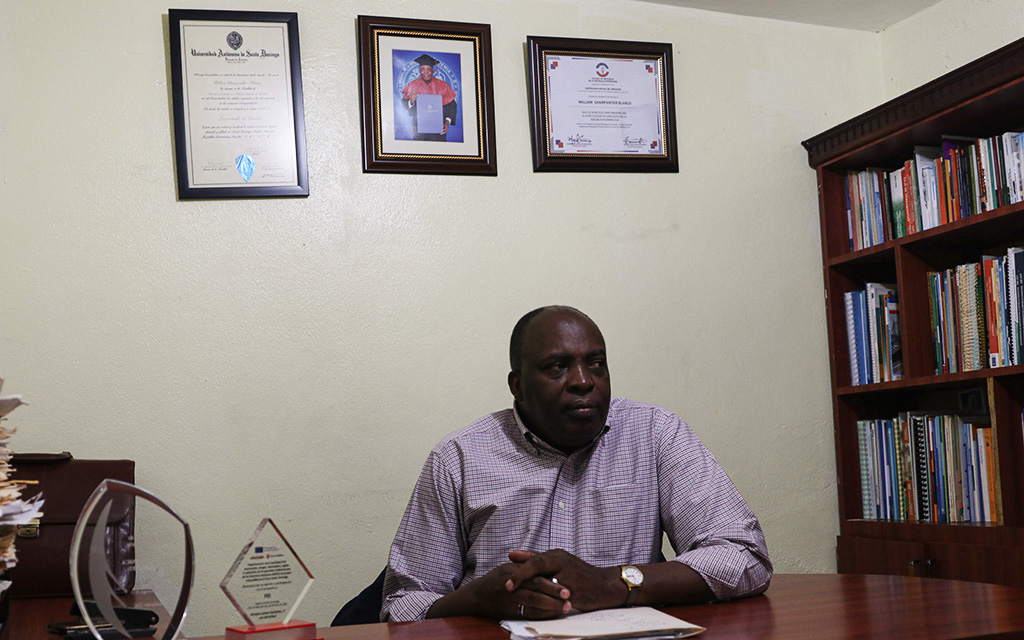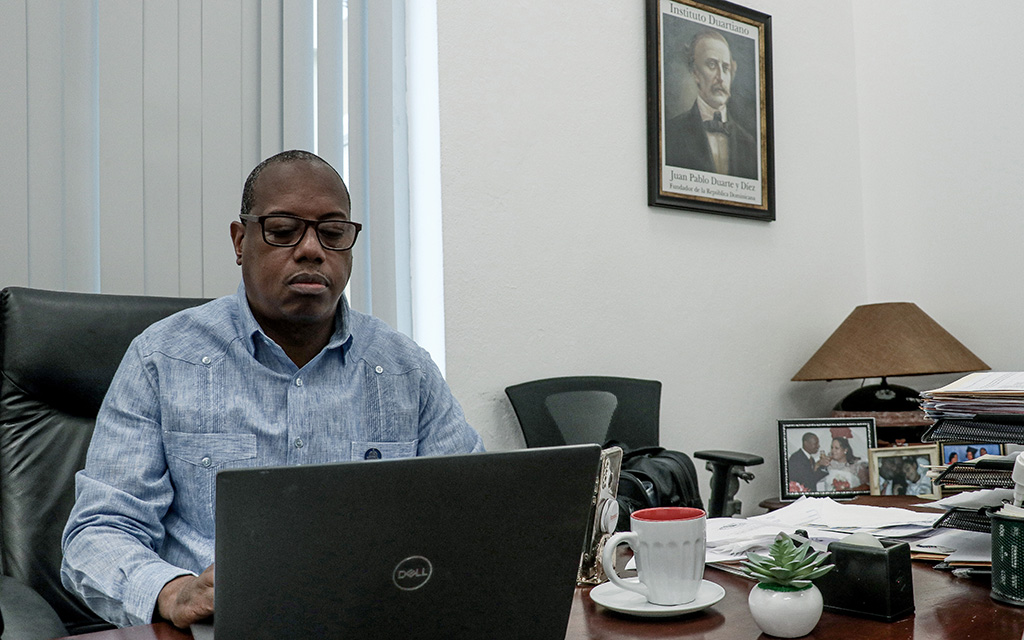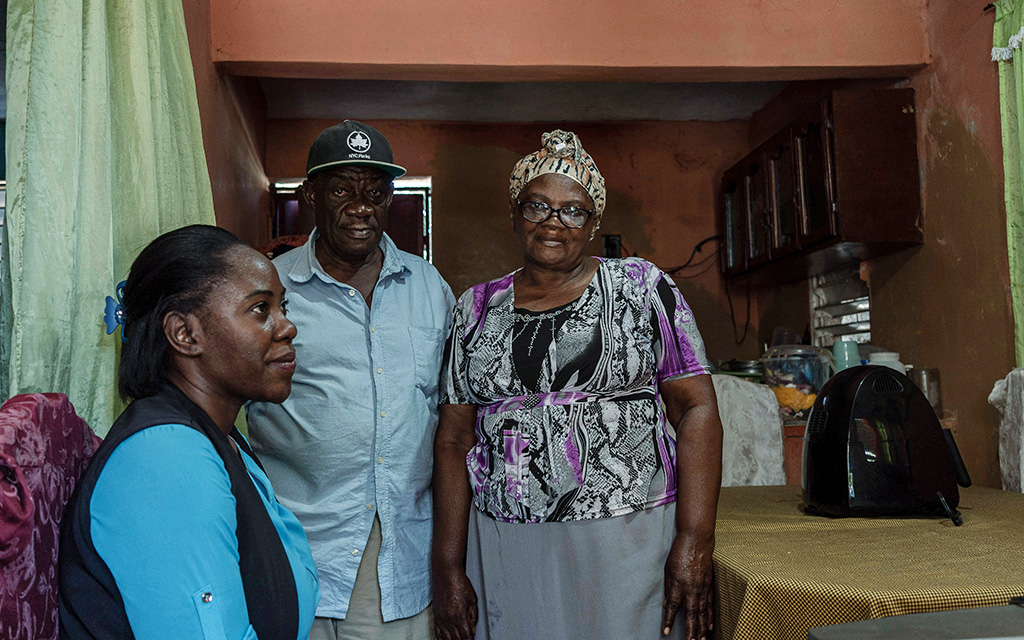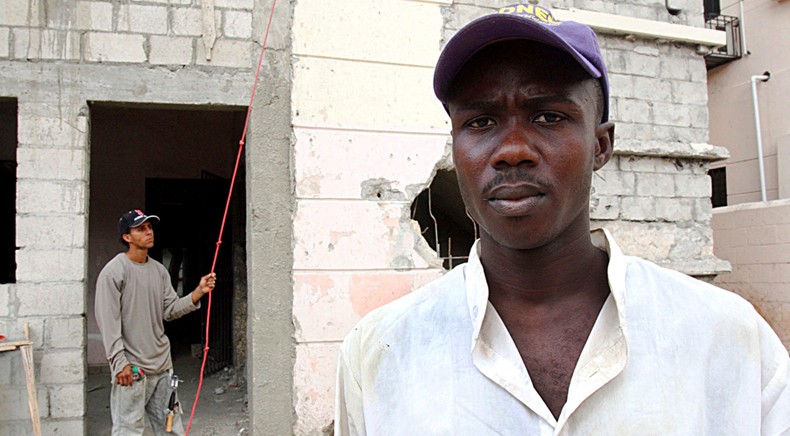
New construction abounds in the capital city of Santo Domingo in the Dominican Republic. Here, a skyscraper is under construction on March 6, 2023. (Photo by TJ L’Heureux/Cronkite Borderlands Project)
SANTO DOMINGO, Dominican Republic – Economically, the Dominican Republic is the crown jewel of the Caribbean.
Over the past decade, its economy has been among the fastest growing in Latin America. Foreign investment is pouring into the country. New construction abounds in the capital city of Santo Domingo. Tourism, which took a dip during the coronavirus pandemic, is booming at a record pace.
At the same time, the country has come under international criticism for its treatment of people of Haitian descent. Recent crackdowns have targeted undocumented new arrivals, longtime residents, and even those born in the Dominican Republic. In November, the country’s deportation of Haitians drew a rebuke from the United Nations High Commissioner on Human Rights and a warning from the U.S. State Department to Black Americans traveling to the country.
Ironically, the group of people Dominican immigration officials are seeking to deport is the same group whose labor has helped fuel the country’s economic boom.
“The Dominican economy relies on indirect taxes of migrants, whether the migrants are legal or not,” said William Charpantier Blanco, coordinator of the National Coalition for Migrations and Refugees. “The growth and development of the Dominican Republic take place thanks to migrant workers, who are largely Haitian.”
There has long been an uneasy interdependence between the island of Hispaniola’s neighbors. While the Dominican Republic is booming economically, Haiti is by most measures the poorest country in the Western Hemisphere. Civil strife has created a power vacuum; large segments of the population live in gang-controlled areas.
Since 1990, both the Dominican Republic and Haiti have seen steep increases in their populations, which are now both nearly equal to the population of Cuba, at about 11 million people – meaning that Hispaniola now has twice the population of Cuba, which is a larger land mass at 42,000 square miles compared to Hispaniola’s 29,000 square miles.
The Dominican Republic’s growth has surprised even lifelong residents.
From behind the wheel, Enger Peña, 28, looks up at the concrete slabs that reach toward the sky in Ensanche Naco, an upper middle class neighborhood in Santo Domingo’s National District. He said that these will be residential buildings.
“They’re building towers. Because there’s too many people.”
Peña drives for Uber, one of several occupations he’s held in the past decade. He feels ambivalent toward the job. “You have to work,” he said. His last job was at a call center in a zona franca, a business or industrial area where the government has offered incentives for corporations to operate. He said the amount of foreign capital entering the country has changed it, especially in Santo Domingo, where he was born and raised.
One island, two economies
Money of external origin has played a major role in transforming the Dominican Republic into one of the Western Hemisphere’s most explosive economies.
Along with an increase in foreign direct investment and huge growth in tourism, the country is receiving greater remittance money sent by Dominicans who have found work in more developed countries to their families still on the island. Remittances alone accounted for 11.4% of the country’s gross domestic product in 2021, according to the World Bank.
These factors helped make the Dominican economy the fastest growing in Latin America and the Caribbean during the 2010s as GDP increased at an average of 5.8% per year, according to the Organisation for Economic Co-operation and Development.
The story is different on the other side of the island. For a country with a similar population size, Haiti’s economic figures are strikingly lower, leaving large segments of its population in dire poverty. The instability of Haiti’s government, plagued by gang violence and civil unrest, in part explains why in 2020, foreign investment in the Dominican Republic was nearly 100 times greater than in Haiti.
‘Everyone knows the Enormous contribution immigrants make’
The Dominican Republic’s economy has a long history of reliance on the labor and contributions of migrants, who have been and remain predominantly Haitian.
In the 1950s, the Dominican Republic and Haiti began signing agreements to bring Haitian laborers to work in Dominican sugar refineries.
“The Dominican economy was based on the sugar industry. It was a fundamentally rural country,” said Charpantier Blanco, the coordinator of the Coalition for Migrants and Refugees (known by its Spanish acronym, MENAMIRD). “Haitians have been contributing to the economy and the growth of the country.”
Charpantier Blanco, a son of Haitian immigrants, noted that while Haitians have been coming to work in the sugar industry for decades, more have been seeking jobs in urban areas or tourism zones. A 2019 study from the Dominican Republic’s National Institute of Migration estimated that Haitian migrant workers made up over 9% of the total workforce and nearly 30% of construction workers, which underscores their importance to the building boom.
Despite the reliance on Haitian labor, a surge of nationalist anti-Haitian sentiment and policies have reverberated through Dominican society since 2010, including new laws that rendered 200,000 people stateless and the construction of a wall on its western border with Haiti.
For decades, children born on Dominican soil were granted citizenship. In 2010, a constitutional amendment retroactively outlawed birthright citizenship for the children of undocumented immigrants.
The amendment was reaffirmed in 2013 by the country’s Constitutional Tribunal, retroactively taking citizenship from children of undocumented immigrants born in the country since 1929. The ruling impacted hundreds of thousands of people, making them unable to work in the formal economy, enroll their children in the public school system or register their newborns. Those affected are mostly of Haitian descent.

William Charpantier Blanco, coordinator of the National Table for Migrants and Refugees, sits in his office on March 3, 2023. (Photo by Caitlin Thompson/Cronkite Borderlands Project)
A new naturalization law was passed in 2014 to mitigate the effects of the court ruling. It allowed people registered as Dominicans to obtain documents needed to exercise their rights as citizens.
But many Dominican and immigrant workers have faced difficulty navigating state systems, either to confirm their nationality or exercise rights like receiving social security, a program to which many contributed for decades. A report from German nonprofit Friedrich-Ebert-Stiftung found that in 2022, about 20,000 former workers were waiting on pensions and over 3,900 died waiting for theirs.
Political rhetoric about Haitian migrants in the Dominican Republic has often reflected political talking points on immigration in the United States, and vice versa. In late May, Donald Trump said that if elected president in 2024, he would end birthright citizenship through an executive order. In the Dominican Republic, it has been argued that Haitian laborers are a drain on social safety net programs, like public health funding.
In a call for greater social acknowledgement of the contributions of Haitian migrants, Dominican sociologist César Pérez wrote that the migrants are not a burden on the Dominican state or economy. He claimed that immigrant contributions to the country’s GDP may be higher than 14%.
“Here, everyone knows the enormous contribution immigrants make,” said Charpantier Blanco, the migrant advocate. “But what happens? They don’t want to recognize it. They don’t want to guarantee migrants’ rights. They don’t want to guarantee protection for them.”
MENAMIRD, Charpantier Blanco’s organization, works to help migrants and refugees obtain key services and resources, which he said are fundamental rights established in Article 38 of the Dominican Republic’s constitution.
Bouncing back from the pandemic: the Abinader presidency
Migrant labor is also key to the tourism sector, which took a major hit when the pandemic rocked the world in 2020. Now, tourism is experiencing a record-setting boom. In May, the government reported a 36% year-over-year increase for the first four months of 2023 and said the sector has been supporting 25% of the nation’s economy over the past several months.
Dominican President Luis Abinader took office in 2020, running as a businessman who had never held elected office and advocating heavily for economic growth policies.
The country rebounded quickly from the pandemic. In 2021, the Dominican Republic’s GDP reached $94.2 billion, a 12.3% increase from the previous year and 6% increase from 2019, the last pre-pandemic year.
Abinader is up for reelection in 2024 and had a 25-point lead in a May 2023 poll conducted by Dominican firm Markestrategia.
Victor Aquino, director of communications at the Ministry of Industry and Trade, is eager to talk about the growth.
“The economy has grown through the strategy of President Abinader,” Aquino said. “President Abinader is an economist. The first thing he did in office was reduce minimum public salaries and implement a plan to create private jobs.”
According to Aquino, the president worked to boost industrial policy and create more jobs in zonas francas, industrial areas that attract private companies by offering low-tax incentives. They are typically known as export-focused manufacturing hubs, but Aquino said the zonas francas are now host to an increasing number of service jobs. For those jobs, certain post-secondary technical skills are required, something to which most Haitians don’t have access, according to Aquino.

Victor Aquino, communications director for the Dominican Republic’s Ministry of Industry and Trade, working in his Santo Domingo office on March 6, 2023. (Photo by TJ L’Heureux/Cronkite Borderlands Project)
He also said the zonas francas and industrial growth have been key to the Dominican Republic’s economic recovery from the pandemic and are part of a larger strategy.
“President Abinader is creating a vision of work in which he is reducing the state and incentivizing industry,” Aquino said.
A ministry press release noted that from August 2020 to November 2022, the administration created 15 new zonas francas and welcomed 204 companies to operate in them, bringing the total figures to 84 and 778, respectively.
Economic growth from the zonas francas has been consistent. Even while GDP growth in construction dropped from 23.4% in 2021 to 0.6% in 2022, the GDP growth related to zonas francas was still 5.4% last year, according to the Central Bank of the Dominican Republic.
In 2021, total investment in the industrial sites reached $5.9 billion, with 80% of funding coming from foreign investors.
According to the Central Bank of the Dominican Republic and the U.S. State Department, the United States is by far the largest source of foreign investment inflows for the Dominican Republic.
The lasting impact of the American military’s occupation
Wilfredo Lozano is the executive director of the National Institute of Migration. He marches into an interview and says he had just come from a meeting with the president at the National Palace, where he was asked to write a memo by that evening. His time is limited.
Lozano is a well-known public intellectual in the Dominican Republic. He is the author of more than 30 books, about a dozen of which are about migratory issues, according to the INM’s website.
He wrote in 2021 that migrant Haitian laborers have gone from confronting complete social, political and geographic exclusion a century ago to currently experiencing “segmented inclusion” in the society and economy of the Dominican Republic.
To explain the origins of current migration trends between the Dominican Republic and Haiti, Lozano rewinds a century.
“Historically, Haitian immigration surged in a particular situation – when the two republics on the island (of Hispaniola) were dominated by the American military apparatus,” Lozano said. “The yankees contributed significantly to the creation of the modern state in the Dominican Republic.”
Investments in sugar were made in the 19th century, mostly by Cuban and Italian investors. But in the 20th century, American investors became interested in entering the sugar business, especially The National City Bank of New York, which later became Citibank.
According to a U.S. State Department historical summary, President Woodrow Wilson in 1915 ordered U.S. forces to invade Haiti,to establish strategic and economic advantage in the hemisphere and block other countries, such as France and Germany, from gaining a foothold in the region. After the invasion, the United States seized control of Haiti’s financial assets.
The American military occupied Haiti from 1915 to 1934. It also occupied the Dominican Republic from 1916 to 1924. The U.S. government handed the finances of both countries to the National City Bank, and with it, ownership of land for sugar production. During the occupations, thousands of people were killed in both countries and widespread human rights violations were recorded, including torture, summary execution and forced labor.
Meanwhile, large investments were made in sugar production during the occupations.
But why did bankers make greater investments in the Dominican Republic than in Haiti?
“It has to do with the power of the campesinos (rural peasants) in Haiti,” Lozano said. “On the Dominican side, the campesinos didn’t have political force. And they were concentrated in the north of the country.”

Dr. Wilfredo Lozano, executive director of the Dominican Republic’s National Institute of Migration, delivers a keynote speech at a migration and development conference in Santo Domingo on Jan. 24, 2023. (Photo courtesy of Instituto Nacional de Migración de la República Dominicano)
When big investments began to pour into the eastern part of the Dominican Republic, producers had a problem: They couldn’t find workers.
Meanwhile in Haiti, there was an abundance of poor rural laborers. According to Lozano, that was partly a result of Haiti’s inheritance laws that required fortunes be passed to the firstborn child. It primed the island for an exodus of poor workers from Haiti to the Dominican Republic, facilitated by the American military.
Borders didn’t matter so much. “The island was administered by the same entity: the United States,” Lozano said.
After the U.S. left Hispaniola, dictators rose to prominence in its absence. Rafael Trujillo, the autocratic who ruled the Dominican Republic for three decades, gave financial support to Haitian presidents to keep the workers flowing.
“Those Haitians never integrated into society,” Lozano said.
‘The poor, the sugar cane workers are dying’
Emilio Boye, a 62-year-old retired cane worker, came to the Dominican Republic when he was 19. He and his daughter, Rosa Boye, are coordinators for the independent Sugarcane Workers’ Union, known as the UTC.
“We are in a constant battle to make sure the government follows through on its responsibilities, like delivering pensions for cane workers,” Rosa Boye said. “They owe workers dignified living, a pension and health care.”
Rosa Boye said many workers became undocumented in 1995 after the Dominican Republic declared that a commonly used worker identification card could not be used as legal documentation. That made it much harder for workers to obtain financial and health benefits.
“A lot of people arrived here as adolescents. They’ve spent their whole life in this country,” she said. “We want them to have a cédula (national identification card) or permanent residence in the Dominican Republic.”
The plight of workers who had not received their pensions drove Jesús Nuñez to begin organizing them into a labor organization that became the UTC. The independent union countered company unions such as the Sindicato Unido de Trabajadores at sugar giant Central Romana, which has allegedly discouraged workers from organizing.
Recently, Nuñez has battled cancer and has sought treatment in Cuba. But Rosa Boye said the union is continuing its organizing efforts in 105 bateyes – ramshackle settlements near sugar mills – pushing corporations and the government to provide benefits and dignified living to both current and retired workers.

Rosa Boye sits as her parents, Emilio and Linda Boye, pose in their home in Santo Domingo’s Bienvenido neighborhood on March 7, 2023. Both Rosa and Emilio are coordinators for the Sugarcane Workers’ Union, and Emilio worked over four decades as a sugar worker. (Photo by John Leos/Cronkite Borderlands Project)
Central Romana, by far the largest sugar producer in the Dominican Republic, entered the international spotlight in November when the U.S. banned imports from the company. The U.S. decision came after Customs and Border Patrol received information “that reasonably indicates the use of forced labor” at Central Romana production sites.
In a conversation with Corporate Accountability Lab, Nuñez denounced the workers’ treatment.
“In a place that is modern, touristy, and industrialized there cannot be a population that is enslaved, surveilled, and abused.”
The wear of the difficult labor is visible on Emilio Boye. He can hardly walk due to swelling in his feet. He suffers from kidney problems, an enlarged heart and constant migraines. His dark eyes are enveloped by a yellow hue and a slight tremor rattles his words.
When workers like Boye can’t obtain proper medical care, their health problems compound and get out of hand. When they aren’t receiving their pensions, it becomes nearly impossible to afford care.
Fortunately for Boye, he receives his pension and is in a relatively good position to afford medications. But his wife Sainteine Jean, who worked as a cook, planter and cultivator for decades, does not receive the pension she is owed, according to their daughter Rosa. (Sainteine Jean is deaf and could not be interviewed.)
“The economic growth of this country is only reflected in the lives of the millionaires,” said Rosa Boye, raising her voice to match the roar of a truck passing on the streets outside. “The poor, the sugar cane workers are dying. They’re dying because they’re sick and don’t have money to buy medications.”
A changing society
While sugar remains a key Dominican export, the country continues to shift away from its historical agrarian economy. And despite the country’s economic gains, Dominicans are continuing to emigrate, legally and illegally, to the United States.
In 1960, there were fewer than 12,000 Dominican immigrants in the U.S, according to Census Bureau data. By 2021, that number was over 1.25 million. There has also been a surge in Haitians seeking refuge in the U.S. For those who find work, the result has been an increase in dollars sent home to family members in both countries.
Olan, a Haitian construction worker who preferred not to share his last name, is helping build residential towers in Santo Domingo. He said Haitians are migrating to cities to participate in non-sugar sectors.
“Nobody wants to come for sugar work,” he said. “It’s much better to work in construction. Or if you speak three languages, (to work in) tourism.”
Olan said he learned Spanish in school, and so he was in a good position to migrate and find work.
The better working conditions of construction, the possibility of living in an urban area and Olan’s knowledge of Spanish highlight changes in the migrant labor market. Historically, Haitian laborers were isolated geographically and linguistically, two factors that enabled government and corporations to wield power over them.

Construction workers build the foundation of a residential tower in Ensanche Naco, an upper middle class neighborhood in Santo Domingo’s National District, on March 9, 2023. It’s estimated that over 30% of construction workers are Haitian migrants. (Photo by TJ L’Heureux/Cronkite Borderlands Project)
Not everyone in the Dominican Republic is happy about that changing, according to Lozano, the migration scholar.
“Little by little, the Haitian population has become more prevalent in Dominican society. A space has to be found for them. And a lot of people are displeased about that.”
Lozano hypothesizes that the recent rise of both nationalist sentiment and economic growth in the Dominican Republic relates back to the history of political power over labor in the island’s countries.
“There aren’t strong unions in this country. Workers don’t have power. That’s key to understanding political stability,” he said. “Haiti has a climate of perpetual instability. The Haitian ruling class could never effectively control the working class and direct it toward a modern industrial state.”
He notes that while there was a democratic pathway to industrialization in England and the United States, industrial development came from more authoritarian avenues in the rest of modern nations, including the Dominican Republic.
To Lozano, the island represents a side-by-side comparison of two economic models. “One is a model that is strategic and despotic, but was ultimately successful. On the other side of the island, workers maintained power, but at the cost of impeding modernization.”
Translating economic wealth into social well-being
At a time when the Dominican Republic’s leaders are undertaking an effort to shrink the state and incentivize business, an agency in the Ministry of Economy is gathering data about social and economic inequality could help the state make decisions that benefit the people who need the most help.
“We have the eighth-biggest GDP per capita in Latin America. But in social results, we are in the bottom,” said Jefrey Lizardo, director of the agency known by its acronym, SIUBEN. “We have one of the highest maternal mortality rates. We have a gap between how you distribute economic wealth into social welfare.”
He said reducing inequality also will require fiscal reform and a greater share of taxes paid by the wealthy.
There are a variety of challenges for remaking policy decisions through data-driven efforts. The Dominican Republic’s economy has a high rate of informal employment. According to the Central Bank of the Dominican Republic, nearly three of five jobs are informal, and so workers aren’t registered.
In addition, recipients of government benefits aren’t always registered. About 30% of pension beneficiaries are not registered, according to Lizardo, presenting a formidable problem that requires SIUBEN to convince agencies to collect more data.
But the most important challenge SIUBEN faces is convincing other government institutions to use its data. In early March, Lizardo said there are five agencies using the data in decision-making processes. Its goal is to have at least 10 agencies using its data by the end of the year.
“This is a process. When you change to (a data-driven) system, you are taking away power from the institution that gets to assign benefits,” said Lizardo, even if those institutions will gain greater ability to identify people who need assistance.
SIUBEN’s challenge is a sobering reminder that the final policy decisions remain political, and the politics of the Dominican Republic remain a consequence of history.
Cronkite Borderlands Project is a multimedia reporting program in which students cover human rights, immigration and border issues in the U.S. and abroad in both English and Spanish.

